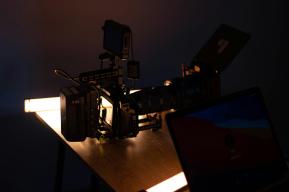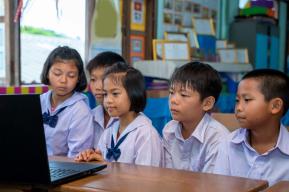Idea
“The collision between text and image opens up a third field of possibilities”

Interview by Agnès Bardon
UNESCO
Was it always your intention to write for children?
Initially, I was interested in doing illustrated books. To tell the truth, when I started out, I wasn't really thinking about the reader. It was a rather vague notion for me. Like a lot of illustrators, I'd embark on a project and ask myself the question of the recipient at a later stage. But the desire to create objects combining text and image led me quite naturally to work for children's publishing. Today, however, I know to whom I'm talking. I want to tell stories at a child's level.
What do you mean by “at a child's level”?
Writing at a child's level means being on a narrow path that needs to be intelligible without being simplistic. It's an exacting requirement. Children don't have the same experience of the world as adults, so you have to put yourself within their reach, while trusting their intelligence. It's important to trust them, because you won't be standing next to them to tell the story.
Writing at a child's level means being on a narrow path that needs to be intelligible without being simplistic
When we talk to children, we naturally tend to place ourselves at their level to establish complicity with them. When I run workshops in classrooms, I often feel the need to crouch or bend down so that the child feels I'm really listening to them. It's a bit like that when you're writing; you have to put yourself in a position of equality with them.
At the same time, children's books have the particularity of being aimed at both children and adults. So you have to speak to two readers at once – the reader, usually an adult, and the listener – and sometimes address one and sometimes the other.
What books or artists have influenced you?
As a child, I loved immersing myself in the world of British cartoonist Quentin Blake. Recently, I came across his drawings again, and I had the same feeling as then, the same desire to enter the house he's drawing, to meet his characters. I've also really enjoyed reading books by Philippe Corentin or Jean-Jacques Sempé. I like it when the characters are very much alive and the image has a strong suggestive power.
These illustrators have influenced me, but I differentiate between what I liked as a child and what I like today as a cartoonist. My drawings are the result of a back-and-forth between the books I would have liked to read as a child and my desire to explore certain forms as a designer. You have to find the right balance between the two. If you only explore, you cut yourself off from your reader, and if you only think about the reader, you deprive yourself of a certain graphic creativity.
How do you organize the relationship between text and images in your books?
They're two different languages. The image should be complementary to the text wherever possible. Some things are better said with words, others with drawings. You have to play with both modes of expression. Sometimes, too, I don't feel like drawing certain scenes, but I am compelled to because I feel the reader will absolutely want to see them. I'm thinking, for example, of a passage in my book Björn, Six Bear Stories, where a hare is playing cards. Depicting this hare doesn't really add to the story, because the scene is already described in the text, but it seemed to me that the reader would want to see it. And as an illustrator, it was a treat for me to show it to the reader.
In an illustrated book, you can also play on the discrepancy between text and image. In Une super histoire de cow-boy [A terrific cowboy story], for example, the drawn story is very different from the one told in the text. There's the text, the image and the collision of the two, which opens up a third field of possibilities.
Do you come up with the ideas for your books before the project begins, or along the way?
When I'm working on a project, the theme, the text, the concept always come first. Right after, everything starts to take shape in my head. I need to visualize the book object very quickly in order to bring it into existence. For example, when I embarked on Une super histoire de cow-boy, I wanted to see what it would be like if I shifted the text and image to the point where they were almost two different stories. My book Le Plus Bel Été du Monde [The most beautiful summer in the world], on the other hand, was born of a desire to draw landscapes. It was only afterwards that I came up with the story. I also wanted to tell the story of the passing of time, of summer. As a result, I used watercolour instead of black and white line drawing, which is my usual style. Incidentally, the project didn't go in the direction I'd originally planned. You have to accept that sometimes the book becomes a path.
You sometimes run workshops in schools. What have you learned from these encounters with your readers?
It's always interesting to meet your readers, because these are moments when you can see if the book has been perceived as you imagined it would be, if things have been lost along the way, or if the child has told himself another story. Once the book is out, it no longer belongs to us completely; it lives its own life.
Meetings with readers are moments when you can see if the book has been perceived as you imagined it would be
When children have read some of my books, a bond is immediately established. I sometimes do illustrated readings, and when the children know the lines in advance, it's a real pleasure. It's as if I've entered through one door, they come in through another, and we find ourselves in the middle of the room, in the fictional world I’ve invited them into and which they've agreed to be part of.






